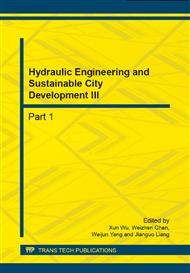[1]
S. Sasikala, N. Tanaka, H. S. Y. Wah Wah, K. B. S. N. Jinadasa. Effects of water level fluctuation on radial oxygen loss, root porosity, and nitrogen removal in subsurface vertical flow wetland mesocosms[J]. Ecological Engineering, 2009, 35(3): 410-417.
DOI: 10.1016/j.ecoleng.2008.10.003
Google Scholar
[2]
C.C. Brueske, G.W. Barrett. Effects of vegetation and hydrologic load on sedimentation patterns in experimental wetland ecosystems[J]. Ecological Engineering, 1994, 3: 429-447.
DOI: 10.1016/0925-8574(94)00011-5
Google Scholar
[3]
J. Coleman, K. Hench, K. Garbutt, A. Sexstone, G. Bissonnette, J. Skousen. Treatment of domestic wastewater by three plant species in constructed wetlands[J]. Water Air Soil Pollut, 2001, 128: 283-295.
DOI: 10.1023/a:1010336703606
Google Scholar
[4]
R.G. Wetzel. Land-water interfaces: metabolic and limnological regulators(Edgardo Baldi Memorial Lecture)[J]. Ver. Int. Ver. Limnol., 1990, 24: 6-24.
Google Scholar
[5]
C.C. Tanner, J.P. Sukias. Accumulation of organic solids in gravel-bed constructed wetlands[J]. Water Science and Technology, 1995, 32: 229-239.
DOI: 10.2166/wst.1995.0145
Google Scholar
[6]
S. Soda, M. Ike, Y. Ogasawara, M. Yoshinaka, D. Mishima, M. Fujita. Effects of light intensity and water temperature on oxygen release from roots into water lettuce rhizosphere[J]. Water Research, 2007, 41(2): 487-491.
DOI: 10.1016/j.watres.2006.10.009
Google Scholar
[7]
B.K. Sorrell, W. Armstrong. On the difficulties of measuring oxygen release by root systems of wetland plants[J]. journal of Ecology, 1994, 82: 177-183.
DOI: 10.2307/2261396
Google Scholar
[8]
N. Dorthe, K. Jespersen, Sorrell, Brian, Brix, Hans. Growth and root oxygen release by Typha latifolia and its effects on sediment methanogenesis[J]. Aquatic Botany, 1998, 61(3): 165-180.
DOI: 10.1016/s0304-3770(98)00071-0
Google Scholar
[9]
X.Q. Mei, Z. H. Ye, M. H. Wong. The relationship of root porosity and radial oxygen loss on arsenic tolerance and uptake in rice grains and straw[J]. Environmental Pollution, 2009, 157(8-9): 2550-2557.
DOI: 10.1016/j.envpol.2009.02.037
Google Scholar
[10]
C. Dong, W. Zhu, M. Gao, L. F. Zhao, J. Y. Huang, Y. Q. Zhao. Diurnal Fluctuations in Oxygen Release from Roots of Acorus calamus Linn in a Modeled Constructed Wetland[J]. Journal of Environmental Science and Health, Part A., 2011, 46(3): 224-229.
DOI: 10.1080/10934529.2011.535391
Google Scholar
[11]
U. Stottmeister, A. Wieβner, P. Kuschk, U. Kappelmeyer, M. Kästner, O. Bederski, R. A. Müller, H. Moormann. Effects of plants and microorganisms in constructed wetlands for wastewater treatment[J]. Biotechnology Advances, 2003, 22(1-2): 93-117.
DOI: 10.1016/j.biotechadv.2003.08.010
Google Scholar


